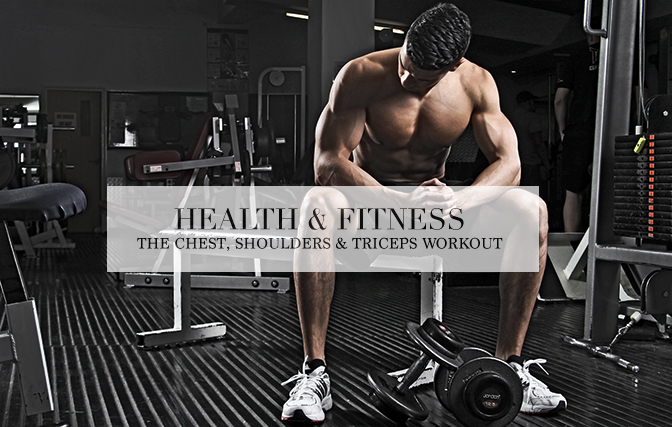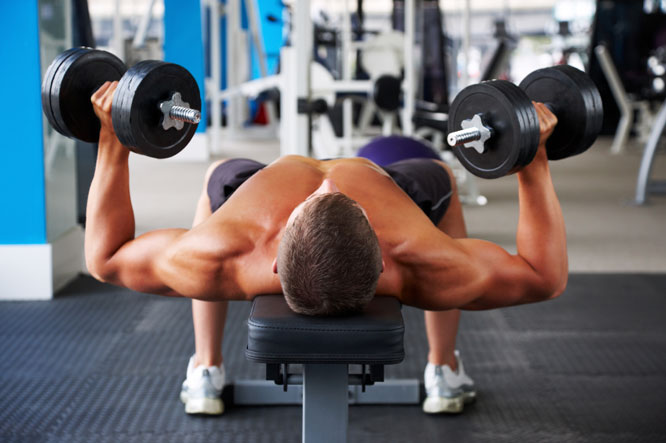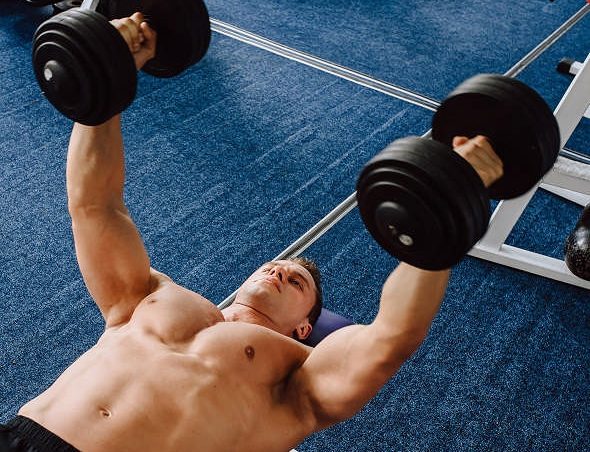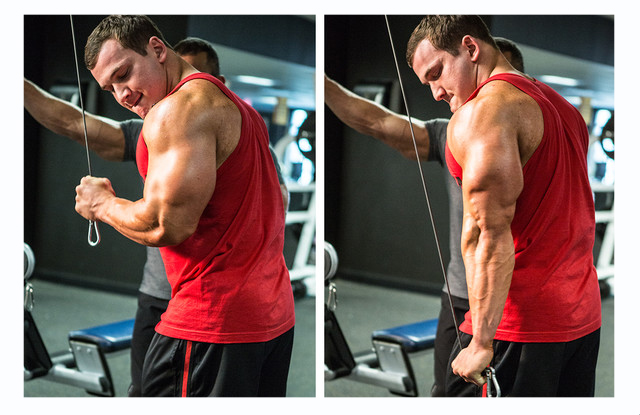It is always crucial that your workouts have some structure. You should never blindly go into a workout without first identifying what it is you want to achieve with each and every session.
For optimal growth and development, you should be aiming to target a muscle or muscle group in a way that fully stimulates the muscle fibres involved. To do this you cannot just rotate at random or exercise as you see fit within your workout session. Every set must have relevance to that workout objective or goal.
Also, you must remember one of the basic rules of muscle building (hypertrophy) and development, which is rest and recovery. We do not grow in the gym, this is where the muscle is torn apart, growth occurs during sleep where the body undergoes a number of biological processes.
For this reason, it’s a great idea to couple exercises in a way that gives each muscle the best quality of exposure to well balanced, fully stimulating workout. We must also acknowledge that we need to allow enough time for muscle recovery, so workout plans needs to account for this.
The chest, shoulders and triceps workout is a classic grouping for many professionals bodybuilders and athletes alike. It makes sense. This is essentially a push workout, in that the muscles utilised are all involved in the push action movement. The fact that they are closely grouped and muscles involved in the actions often overlap, helps to maximise the intensity onto a focused region – therefore giving the muscles a much more robust workout.
The opposite – the pull workout – would involve the back and biceps as the biceps are heavily stimulated in all pulling movements. Grouping muscles in this way allow you to minimise overstress when those muscles should be in a recovery period.
Note: This particular workout has a greater emphasis on chest development over shoulders and triceps.
It can be a good idea to focus on a specific muscle group more so when utilising this method so that you can force the muscles to undergo higher levels of intensity or stimulation. Performing this workout without a particular focus will mean that it should be a somewhat balanced workout but, this is where many people often fail in muscle development…you need to find a way to shock the muscles!
As fatigue sets in, the sets you perform later in your workout will not be as aggressive and stimulating for your muscles. This means imbalances in muscle development will occur over time. Changing the order of this work out slightly may correct some imbalance due to fatigue but, you can also tweak this plan somewhat to emphasise shoulder development – removing or adding a few exercises to move the focus and intensity towards the shoulders.
The Workout:
Note: Before you start this workout make sure your shoulders are warmed up! Pressing exercises, especially on the chest, can place a lot of stress onto the shoulder joint – resulting in injury if the shoulder hasn’t been sufficiently warmed up.
Dumbell Chest Press
Sets 5 Reps 6-15
Your first set should be a warmup set for the pectorals. For this, we suggest using a light-medium weight where you can manage 15 reps in a very controlled manner. You should be focused on squeezing the pectorals throughout the movement, and maintaining tension throughout by not fully straightening your arms at the peak of the movement.
Your next sets involve challenging yourself and shocking the muscles. This is done by a pyramid set training – where your goal is to incrementally increase the weight lifted.
Set 2 should be a medium-heavy weight – your ‘regular’ go to weight. A weight where you can do 10 reps. This should be in a controlled tempo throughout the set. Do not straighten at the peak of the movement – maintain tension throughout.
Set 3 should be a more challenging set. Try an extra 2kg onto each dumbbell. Attempt 8-10 reps.
Set 4 should be an addition to the weight load – a further 2kg to the previous onto each dumbbell. Reps range is 6-8. As this will be challenging you may require an extra minute rest between this and the previous set. As this set is about pushing the boundary, it is likely that your form will be off – this is fine in this instance.
Set 5 should be back to the weight you began with, in Set 1. Perform 10-15 reps. The goal of this set is to squeeze the pectorals as much as you can. Do not ‘focus’ on moving the dumbells up and down instead, focus on tensing your pectoral muscles as hard as you can throughout the whole of the movement. Keep the tempo steady, maintain tension for the entirety of the movement – no straightening of the arms. This set helps to force blood (known as the pump) through the pectorals, further stimulating them. As the previous set was much higher, this set trains your mind to adjust and focus on control and contraction and recruiting as many muscle fibres as you can. By the way, this set burns!
Incline Chest Press
Sets 2/3 Reps 8-10
- Focus on squeezing the upper pectoral. Maintain strict form – this means a controlled tempo, not overstretching as you move to the peak of the contraction as this will place more tension on the shoulder and away from the upper pectorals.
- Keep your shoulder blades pinned back to prevent hyperextension of the shoulder.
- Do not lower your arms too deep on the lowering phase of the movement as you could place too much tension on the shoulder joint, causing injury.
- Finally, do not fully straighten your elbows at the peak – maintain the tension at all times.
Incline Shoulder Press (Smith-Machine)
Sets 2 Reps 10-15
- This set removes some of the stability muscles involved in the pressing movement so that you can isolate more onto the target muscle.
- Be careful with this exercise as the fixed position of your grip may cause extra stress on your wrist. Also, your shoulders naturally slide laterally as you extend your arms above your head – the bar barbell, unlike dumbbells, prevents lateral movement. This means you must be very careful when increasing the weight as an injury occurs easily.
- This exercise is perhaps one of the best for frontal deltoid development. Start with a manageable weight – do not go too heavy. Place the bench just off verticle position so there is a slight lean.
- To execute this exercise start with a grip that’s just off shoulders width.
- Next, retract your shoulders and shoulder blades down and back – maintain this strong form throughout the entire movement. Once the bar is off the hook, slowly bring the bar down to just below your chin. Then press up, initiating the movement with your front deltoids first.
- Do not hyperextend your shoulders and do not at any point straighten your elbows as this will place too much stress on the shoulder joints.
Dumbbell Shoulder Raise
Sets 3 Reps 10-12
- This has a greater focus on the medial deltoid.
- Do not go too heavy, lighter weights work best for this exercise. Many make the mistake of lifting heavy and almost swing the weight up using momentum. Avoid this by going lighter and fully controlling the weight.
- Stand straight with a slight bend in your knees and keep your abs and core tight.
- Bend at slightly forward at your waist – this shifts the line of tension more onto the medial deltoids and away from the anterior deltoid if you were up straight.
- Allow for a slight bend in your arm to take the tension away from the elbow joint.
- Lift each weight up beside you making sure that they don’t come forward too much as this will place greater tension on the anterior (front) deltoids.
- Raise your arms so that they are parallel to the floor – do not go higher.
- Your goal is to focus the contraction on the medial head of the deltoid, to do this lead with your elbows and upper arm, not your hands and lower arm. This means that at the peak of the movement your elbows should be aligned above your hands.
Flat Bench Dumbbell Flys
Sets 3 Reps 10
- This is a great shaping exercise that you could do near the end of your workout. This exercise helps to stretch the pectorals – it targets the outside of the chest then as you come together it hits the inside of the chest.
- This exercise isolates the pectorals removing some of the muscle utilised in a standard dumbbell bench press.
- Start with the dumbbell straight above you, then bend your arms slightly – this is the position that you should maintain throughout most of the movement.
- Your aim is to move your arms down in a semi-circular action out beside you. Slowly lower the weight down until you feel a good stretch in your outer pectorals whist maintaining that slide bend in your arms.
- Then bring the weight back up in that same action as before, whilst concentrating on squeezing your pectorals hard.
Tip: Think less about the movement of the arms and more about the contraction and squeezing of the chest. To best understand this, pose in front of a mirror, arms relaxed by your sides, and try to tense your pecs – contracting as hard as you can – then relax and repeat.
As you draw your arms to the peak of the movement only then can you straighten your arms to maximise the contraction of the inner chest. To do not bring the weight together at the top and make sure that there is tension on your chest throughout the whole exercise.
One Arm Overhead Cable Triceps Extension
Sets 3 Reps 10-15
- Set the cable to waist height for safety reasons as this will stop the cable from swinging and when you drop the cable back down it will not move as far – reducing any risk of injury.
- This exercise starts by placing your triceps in an elongated position. It isolates the triceps more than say triceps pushdowns, which makes it a very effective exercise.
- Start by bending your knees slightly, tighten your core, and stand up straight.
- Pick a manageable weight that you could do 10-15 reps with.
- Bring the cable up above you head and turn facing out from the cable machine. Keep a fixed and stable shoulder – it shouldn’t be used in the exercise. Then lower the cable behind your head slowly so that the triceps is further stretched. Once you reach the bottom of the movement, contract the triceps and bring it back up, locking your elbows at the top.
One Arm Cable Triceps Extensions
Sets 3 Reps 10-15
- Set the cable to its highest level. Draw the cable down and point your elbow down hard towards the ground and close to your side. Flex your triceps bringing the cable down and lock out your elbows, then slowly come back up maintaining tension onto the triceps throughout.
- If you want to challenge yourself, on your final set you could do some assisted negatives. Once you have managed all of the reps in the last set, simply use your free hand to assist with bringing the cable down. Make sure that you keep some tension in the working arm as you assist it with bringing the cable down. Then take your free hand away and slowly allow the working arm – in a controlled, slow manner – to come back up. Try this for as many reps as you can manage
Triceps Dips
Sets 3 Reps To Failure
- Triceps dipsare one of the best triceps exercises.
- Make sure that the grip is narrow with your arms close to your body.
- Keep your torso upright with your head neutral.
- Keep your legs pinned back behind you.
- Point your elbows back not towards the sides.
- Lower so that your shoulders align just below your elbows.
- Push up initiating the movement from your triceps and lock out at the peak.
- Minimise any body swing.





Hey THE LOST GENTLEMAN,
Is training all these big muscles at same day is good? Will it recover in few days? and what about adding some cardio after workout for burning stored energy?